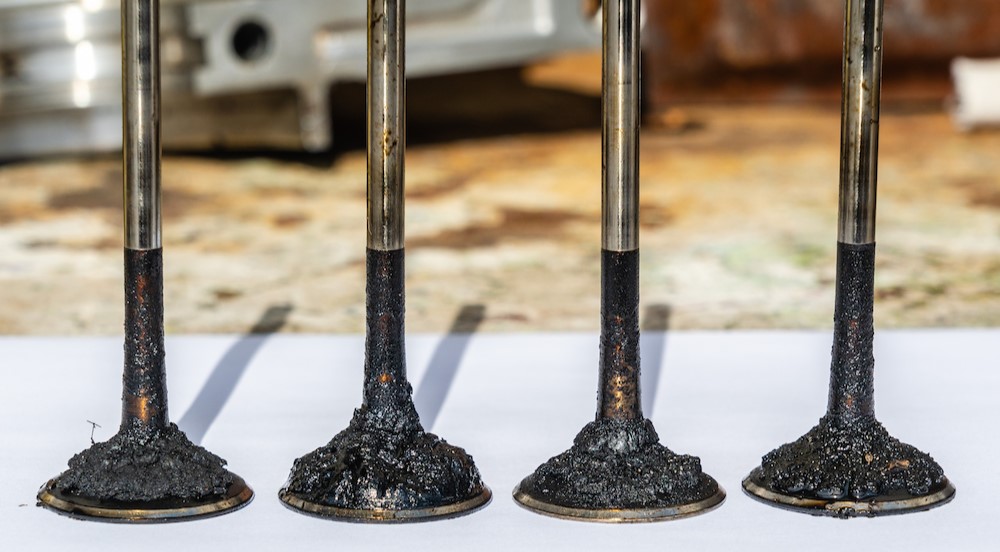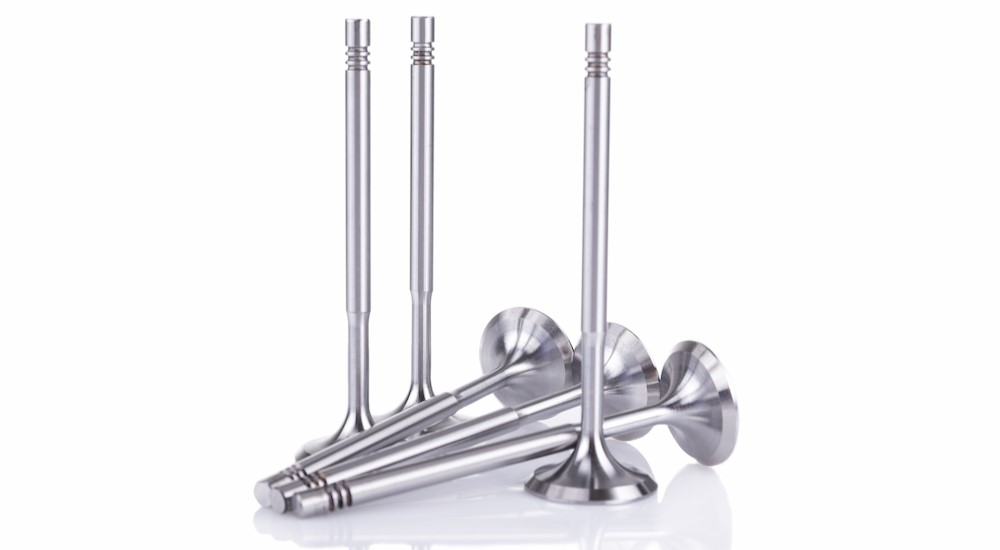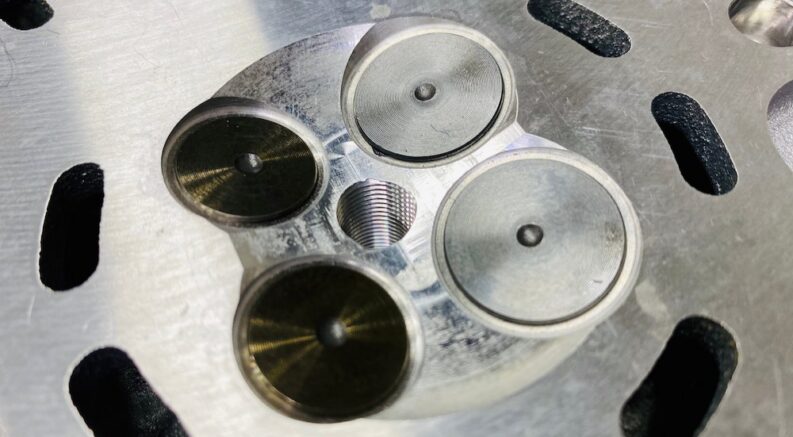Internal combustion is a marvel of modern engineering, but it does have some downsides. The average V6 engine will undergo around 9,000 small explosions every minute as the fuel is ignited. While this proves effective at pushing a car, truck, or SUV down the road, it also results in some by-products that can easily befoul one of the engine’s key components. Intake valves serve an important role in any gas-powered vehicle, opening during the engine’s intake stroke to allow the mixture of air and fuel to enter the engine and then quickly closing to create the tight seal needed for the compression and combustion strokes.
While most of today’s engines are incredibly efficient, the internal combustion process isn’t perfect, and there are bound to be some contaminants left behind when you’re relying on little explosions as a means of propulsion. The gas used to power vehicles tends to result in the subtle buildup of carbon deposits over time, which can cause serious problems if not addressed with regular intake system cleaning. Read on as we explore why the deposits can be so harmful, discuss which types of engines require intake cleaning, and cover some basic techniques that’ll have you enjoying miles upon miles of worry-free driving.
Why Is It Important?
We’ll start by outlining a few simple reasons why drivers should consider performing an intake manifold cleaning. From improved performance and efficiency to preventing obnoxious noises and preserving your engine, there are plenty of arguments for breaking out a can of intake cleaner. Let’s review some of the most convincing arguments and learn how drivers can help to ensure long-term reliability and performance with a few simple steps.
The most compelling reason to keep up with your intake cleaning regime is pure dollars and cents. Your engine is easily the most expensive component in any vehicle. While many issues can be addressed for the right cost, some problems can turn the car into a useless hunk of metal that isn’t worth repairing.
Severe carbon buildup can cause the engine to misfire, stall, or overheat. While these symptoms aren’t the end of the world, they can essentially brick an engine if given enough time. Dirty valves can result in engine knocking, which occurs when the air-fuel mixture ignites too soon. This phenomenon creates a distinctive knocking or pinging sound and can cause serious damage to the pistons and cylinder walls if not promptly addressed.
If you hope to achieve the optimum horsepower and fuel economy you were promised when you first purchased your vehicle, proper intake system cleaning can’t be underestimated. An engine is one of a vehicle’s most precisely calibrated parts, relying on exact ratios and minuscule measurements to work at its best. When carbon deposits build up, these calculations can be thrown all out of whack, resulting in pedestrian performance and a pricey visit to the gas pump. In addition to mucking up the valves, carbon deposits can also impact an engine’s ports and cylinder walls. Regularly cleaning your intake system can put money back in your wallet and a little extra oomph under the hood. If your output and efficiency aren’t what they once were or you notice knocking or a rough idle, it might be time to perform a thorough cleaning.

What Vehicles Need It?
Before we cover some of the recommended techniques for intake system cleaning, we should address one major misconception around the practice. Not every vehicle typically needs it. While a thorough intake cleaning can yield some major benefits in the case of an engine designed with direct injection systems, those employing the port injection approach are a little different.
Here’s a quick refresher for those who skipped out on auto shop in school. In an engine that utilizes port injection, fuel is sprayed directly onto the intake valves. This design offers some advantages in terms of fuel efficiency and emissions. Also, it has the secondary effect of helping to keep the intake valves free from the harmful buildup of carbon deposits. Most fuel manufacturers formulate their product with added detergents that help to steadily remove carbon deposits every time fuel washes over the intake valves.
This is where direct injection comes up short. While it might run on the same type of fuel, an engine that uses direct injection sees the gas dumped directly into the combustion chambers. Since it bypasses the intake valves, a direct injection system can’t take advantage of these cleaning properties, which leaves drivers vulnerable to decreased performance and efficiency, a rough idle, and potential long-term damage.
That’s not to say that a port injection system is maintenance-free. It all depends on how a vehicle is used, its mileage, and the type of fuel you choose. If your ride is regularly subjected to harsh conditions or engages in a lot of stop-and-go driving, carbon buildup can even become an issue in a vehicle that relies on port injection. The same goes for engines with higher mileage. No matter how well today’s modern fuels might work when it comes to cleaning intake valves, carbon deposits are bound to accumulate when you start pushing the 100,000-mile mark.
The type of fuel also plays an obvious role. Some cheaper, lower-quality fuels lack the advanced detergents found in pricier options, so while you might save a few bucks in the short term, it’s important to consider the impact over time. As with most vehicle repair and maintenance tasks, drivers should also consider the manufacturer’s recommendations. Every make and model carries its own unique requirements, which will typically be outlined in the owner’s manual.

How to Clean the Intake Valves
There are two main approaches to cleaning an engine’s intake valves. Those who are less mechanically inclined can choose a lower-effort technique that involves spraying a bottle of intake valve cleaner into the intake manifold, while drivers who know their way around a wrench can opt for a more comprehensive process that requires fully removing the valves.
Unless your vehicle is in pretty rough shape, or you own a vehicle that uses direct injection and is past the 100,000-mile mark, the first option probably makes the most sense. Start by grabbing a bottle of intake valve cleaner from the local auto parts store. Then, locate the intake manifold and remove it according to the manufacturer’s instructions. Some cleaners require subtly different steps, but generally speaking, you’ll want to apply a liberal amount of spray and give it a little time to start dissolving the carbon deposits. You can use a toothbrush or some other sort of soft brush to scrub away the deposits, and then remove them with a clean cloth. Repeat the process until all the valves are clean, then use a vacuum to remove any gunk that might remain. Finish by reassembling the intake manifold and take a short test drive before hitting the open road to make sure all your handiwork did the trick. Some vehicles might require the vehicle to be running while the cleaning is performed, in which case you’ll want to get the engine up to its normal operating temperature, disconnect the air intake boot, and then use the straw that comes with the cleaner to spritz the intake manifold while the engine is running at between 2,500 to 3,000 RPM.
The manual cleaning method is a little trickier, and the steps can vary depending on the specific vehicle. Generally speaking, you’ll want to remove the intake manifolds and valves, and then dump the valves in a dedicated cleaner or solvent. This approach allows drivers to clean the components well, using scouring pads or even a drill with a soft brush attachment. For best results, polish the valves after cleaning and then reinstall everything while paying close attention to achieving a tight seal.
If this all sounds a little overwhelming, or you prefer to leave such projects to the professionals, your local auto shop or dealership can provide the sort of expert touch that will go a long way towards ensuring a safe, confident driving experience for years to come. A skilled mechanic can leverage their knowledge to return your intake valves to their original condition and inspect the engine for any damage that pesky carbon deposits might have incurred. A can of intake valve cleaner can work wonders if you just need a little touch-up, but they’re no substitute for the type of service an accomplished auto technician can offer. If your car isn’t performing at its best, or you’re trying to keep a high-mileage vehicle on the road for as long as possible, cleaning the intake valves can breathe new life into even the most well-traveled engine.

